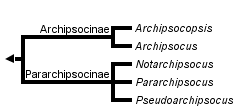Archipsocetae
Archipsocidae
Emilie Bess and Kevin P. Johnson


This tree diagram shows the relationships between several groups of organisms.
The root of the current tree connects the organisms featured in this tree to their containing group and the rest of the Tree of Life. The basal branching point in the tree represents the ancestor of the other groups in the tree. This ancestor diversified over time into several descendent subgroups, which are represented as internal nodes and terminal taxa to the right.

You can click on the root to travel down the Tree of Life all the way to the root of all Life, and you can click on the names of descendent subgroups to travel up the Tree of Life all the way to individual species.
For more information on ToL tree formatting, please see Interpreting the Tree or Classification. To learn more about phylogenetic trees, please visit our Phylogenetic Biology pages.
close boxIntroduction
The family Archipsocidae contains about 80 species in 5 genera distributed worldwide, with highest diversity in Central and South America. Seven species are known from North America in the genera Archipsocus, Archipsocopsis and Pararchipsocus.
These are small to medium-sized bark lice (1-3 mm, nymphs 1.5-2.5 mm). Body colors are red- or orange-brown, sometimes pale. Almost all body surfaces are densely covered with long hairs. Wings are creamy white. Archipsocids live on the surface of bark, often in groups under dense webs, and subsocial behavior has been observed in some species.
Morphological and molecular data both suggest that Archipsocidae is sister to the remainder of suborder Psocomorpha. The family has been placed in its own infraorder, Archipsocetae (Yoshizawa 2002, Johnson et al. 2004).
Characteristics
Synapomorphies
- Leg: pretarsal claw lacks a preapical tooth.
- Forewings:
- Forewing veins and membrane are covered with long hairs.
- Hairs on forewing margin form crossing pairs.
- Forewings have reduced venation.
- Male: parameres are reduced and membranous.
- Female: gonapophyses lacks a ventral valve.
- Behavior: All known species of this family live in groups on bark or dead leaves beneath sheets of webbing. Subsociality has been documented in Archipsocidae.
General Characters
- Head:
- Antennae have 13 segments.
- Antennae are hairy.
- Leg: Tarsi have 2 segments.
- Wings:
- Most species have short-winged males and both long- and short-winged females (all North American species have females with long wings).
- Forewings have reduced veins:
- Full-length forewings are hairy.
- Shortened forewings are 1/3 length of abdomen, hairy and “leathery.”
- Forewing vein M is not branched.
- Cubital loop has distinct Y-shape, and doesn't hit wing margin before loop.
- Pterostigma is shallow.
- Areola postica has flat shape, not curved.
- Hindwing surface and margin are covered with hairs, but veins are hairless.
- Male:
- Phallosome is simple.
- Parameres are reduced and membranous (sometimes absent).
- Female:
- Subgenital plate is rounded or flattened distally.
- Some species are viviparous with gonapophyses absent or very reduced.
- In oviparous species gonapophyses are reduced:
- Ventral valve is absent.
- Dorsal valve is slender and pointed.
- External valve is broad and hairy.
- Eggs: Eggs are covered with debris, but not covered with silk threads.
How to Know the Family
- Often found in colonies under dense webs on the surface of tree trunks.
- Body is hairy and red- or orange-brown.
- Most species have short-winged males and both long- and short-winged females (all North American species have females with long wings).
- Full-length forewings are hairy.
- Forewings have reduced veins:
- Shortened forewings are 1/3 length of abdomen, hairy and “leathery.”
- Forewing areola postica has flat shape, not curved.
- Forewing vein M is not branched.
- Cubital loop has distinct Y-shape, and does not hit wing margin before loop.
Family Monophyly
Monophyly of Archipsocidae is strongly supported by several morphological synapomorphies (see Characteristics; Yoshizawa 2002) and by molecular data including three mitochondrial and one nuclear gene (18S nDNA; 12S, 16S, COI mtDNA, Johnson & Mockford 2003, Johnson et al. 2004).
References
Badonnel, A. 1966. Sur le genre Archipsocus Hagen (Psocoptera, Archipsocidae). Bulletin du Muséum National d'Histoire Naturelle, Paris 38:409-415.
Johnson, K. P. & E. L. Mockford. 2003. Molecular Systematics of Psocomorpha (Psocoptera). Systematic Entomology 28: 409-40.
Johnson, K. P., K. Yoshizawa, and V. S. Smith. 2004. Multiple origins of parasitism in lice. Proceedings of the Royal Society of London B 271:1771-1776.
Lienhard, C. and C. N Smithers. 2002. Psocoptera (Insecta) World Catalogue and Bibliography. Muséum d'Histoire Naturelle, Geneva, Switzerland.
Mockford, E. L. 1993. North American Psocoptera (Insecta). Gainesville, Florida: Sandhill Crane Press.
New, T.R. 2005. Psocids, Psocoptera (Booklice and barklice), 2nd edition: Handbooks for the Identification of British Insects. Vol. 1, Part 7. Royal Entomological Society, London, UK.
Smithers, C. N. 1996. Psocoptera. Pp. 1-80, 363-372 (Index) in Wells A. (ed.) Zoological Catalogue of Australia. Vol. 26. Psocoptera, Phthiraptera, Thysanoptera. Melbourne: CSIRO Publishing, Australia.
Yoshizawa, K. 2002. Phylogeny and higher classification of suborder Psocomorpha (Insecta: Psocodea:'Psocoptera'). Zoological Journal of the Linnean Society 136: 371-400.
About This Page
Emilie Bess

Illinois Natural History Survey, Champaign, Illinois, USA
Kevin P. Johnson

Illinois Natural History Survey, Champaign, Illinois, USA
Correspondence regarding this page should be directed to Emilie Bess at and Kevin P. Johnson at
Page copyright © 2009 Emilie Bess and Kevin P. Johnson
All Rights Reserved.
- First online 25 March 2009
- Content changed 25 March 2009
Citing this page:
Bess, Emilie and Kevin P. Johnson. 2009. Archipsocetae. Archipsocidae. Version 25 March 2009 (under construction). http://tolweb.org/Archipsocidae/14477/2009.03.25 in The Tree of Life Web Project, http://tolweb.org/





 Go to quick links
Go to quick search
Go to navigation for this section of the ToL site
Go to detailed links for the ToL site
Go to quick links
Go to quick search
Go to navigation for this section of the ToL site
Go to detailed links for the ToL site